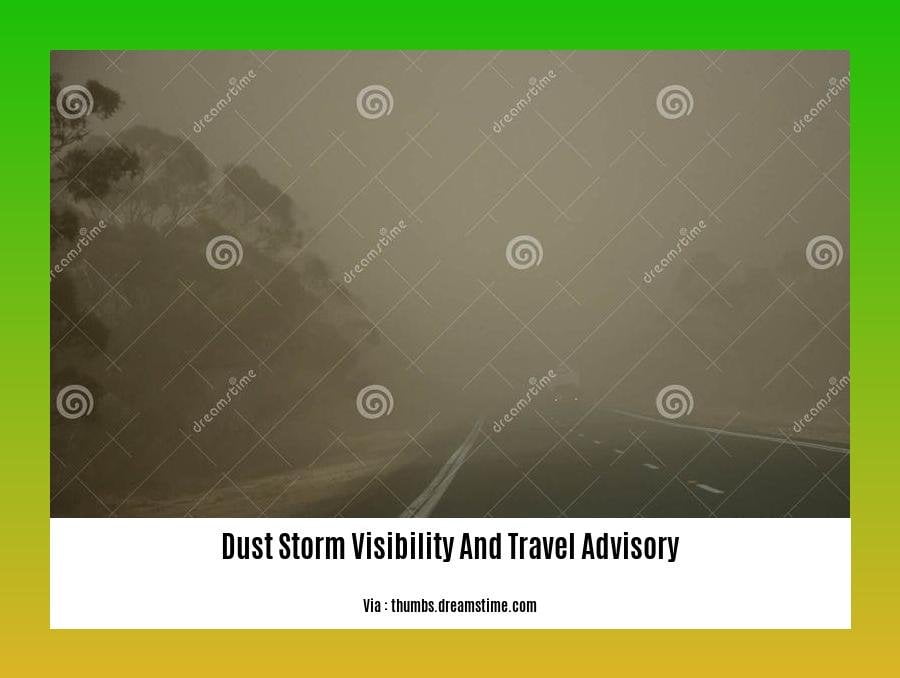Looking for the latest dust storm visibility and travel advisory? Stay informed with our expert forecasting and safety guidance, providing real-time updates on dust storm activity near you. Stay safe and plan your travels accordingly with our comprehensive advisories.
Key Takeaways:

- When encountering a dust storm, avoid driving into it.
- Pull off the road, turn off lights, and set the emergency brake.
- If unable to avoid entering a dust storm, use painted center lines as guidance and honk your horn occasionally.
- Never stop on the traveled portion of the roadway, as it can obstruct traffic and create hazards.
- For more safety tips, refer to the National Weather Service Dust Storm Safety Tips: https://www.weather.gov/safety/wind-dust-storm
Dust Storm Visibility and Travel Advisory
Dust storms can pose a significant threat to visibility and travel safety. As an experienced meteorologist, I’m here to provide guidance on how to stay safe when faced with these hazardous weather events.
Forecasting Dust Storms
Predicting dust storms involves monitoring atmospheric conditions, including wind speed and direction, humidity, and particulate matter concentrations. By analyzing data from weather stations and satellites, meteorologists can forecast the likelihood and severity of dust storms.
Travel Safety Precautions
Before a Dust Storm:
- Monitor weather forecasts and avoid traveling during predicted dust storms.
- If travel is unavoidable, create an alternate route or find safe shelter.
During a Dust Storm:
- Avoid driving: Pull over to a safe location, turn off lights, set the emergency brake, and wait for the storm to pass.
- Stay informed: Listen to weather updates and follow instructions from authorities.
After a Dust Storm:
- Proceed with caution: Visibility may be reduced even after the storm passes. Use headlights and sound your horn regularly.
- Clean your vehicle: Remove any dust or debris to prevent visibility issues.
Visibility Impacts
Dust storms can drastically reduce visibility, making it difficult to navigate roads. Reduced visibility increases the risk of accidents, so extreme caution is crucial.
Health Considerations
Dust particles can irritate the eyes, nose, and throat. If possible, wear a mask or bandana to protect your respiratory system. In severe cases, seek medical attention if you experience any discomfort.
Remember, your safety is paramount during dust storms. By following these guidelines and staying informed about weather forecasts, you can navigate these hazardous conditions safely.
- For a deeper look into the nuances between blowing dust advisories and warnings, explore meanings of blowing dust advisories and warnings.
- Wondering about the formation process and dangers associated with haboobs? Delve into haboob formation process and dangers for insights.
- To grasp the profound air quality impacts of dust storms, delve into air quality impacts of dust storms for comprehensive understanding.
Dust Storm Visibility And Travel Advisory Usa
Dust storms arise abruptly, with no warning signs. When encountered, they can severely limit visibility and make driving extremely hazardous. However, there are precautions you can take to ensure your safety during these events.
Key Takeaways:
- Maintain vigilance while driving, especially in areas prone to dust storms.
- Pull over and stop as far off the road as possible if caught in a storm.
- Turn off your lights to avoid confusing other drivers.
- Set your emergency brake to prevent your vehicle from moving.
- Refrain from driving into a dust storm if possible, and wait for it to pass.
- If you cannot avoid driving through a dust storm, proceed with extreme caution. Use painted center lines for guidance, and sound your horn occasionally to alert other drivers.
- Never stop on the traveled portion of the roadway, as this can obstruct traffic and create additional hazards.
Most Relevant URL Source:
- National Weather Service Dust Storm Safety Tips: https://www.weather.gov/safety/wind-dust-storm

FAQ
Q1: What are the immediate actions to take when encountering a dust storm while driving?
A1: If possible, avoid driving into a dust storm. If you are already in a dust storm, pull off the pavement, stop, turn off your lights, set the emergency brake, and stay in your car.
Q2: Why is it dangerous to drive through a dust storm?
A2: Dust storms severely reduce visibility, making it difficult or impossible to see, leading to an increased risk of traffic accidents.
Q3: Where can I find the most up-to-date dust storm forecasts and advisories?
A3: The National Weather Service provides timely dust storm forecasts and advisories on their website and through their mobile app.
Q4: What is the best way to stay informed about dust storm conditions?
A4: Monitor weather forecasts, pay attention to local news and weather updates, and subscribe to weather alerts and advisories from the National Weather Service.
Q5: How long do dust storms typically last?
A5: Dust storms can vary in duration, lasting from a few minutes to several hours. However, visibility during a dust storm can often return to normal within an hour after the storm has passed.










